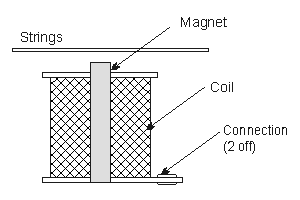
I dont have to let you guys know what the hell is this, but it is available again!
Price RM1,700.00 (nett)
Call me 019-5757953 Boi

A guitar pickup is a very simple electro-magnetic device, which would be instantly recognisable to Michael Faraday, the great pioneer of electromagnetism.
 Construction of a typical single coil guitar pickup |
In its simplest form, the standard "single coil" guitar pickup, as fitted to Tele or Strat style instruments, the pickup consists of (usually) six permanent magnets, with several thousand turns of fine copper wire wound around them. To those of you who still have a distant memory of physics lessons in school, this should bring to mind the definition of a basic generator or dynamo - "The production of an electrical potential difference (or voltage) across a conductor situated in a changing magnetic flux". The vibrating steel string cutting the lines of magnetic flux causes the change in flux in the "conductor", ie the coil of copper wire.
As guitarists who use instruments equipped with single coil pickups will testify, they are equally effective at picking up stray 50 or 60Hz fields radiated by AC mains wing and equipment as they are at picking up the vibration of the strings! I am sure we have all ended up playing our guitars in weird and wonderful positions, just to minimise the infernal buzz! This led to the development of the "humbucking" pickup. This is again a simple device, imagine two single coil pickups placed side by side and both connected in series - if these pickups were identical, then they would both pick up the same amount of string vibration and background hum: the voltages would be added together but the ration of signal to noise would be the same.
 Construction of a typical humbucking pickup |
The clever twist that makes the humbucker so effective is that in, one pickup, the permanent magnets are effectively mounted upside down (usually there is only one bar magnet with the North pole touching the base of one set of polepieces, and the South pole touching the other set), and the coil is reversed. This effectively means that the signal produced by the vibrating string is unchanged, whereas the hum signal produced by pickup of stray magnetic fields is reversed (remember that the string signal is produced by the interaction of the magnet and the coil, but the hum is purely picked up by the coil). When the signals from the two coils are mixed together, the signal from the vibrating strings is effectively twice that of a single coil, but the hum signal is reduced to almost zero, as the hum signal from the two coils have opposite polarities. In practice, there will still be a small amount of hum, as the two coils are very rarely identical.